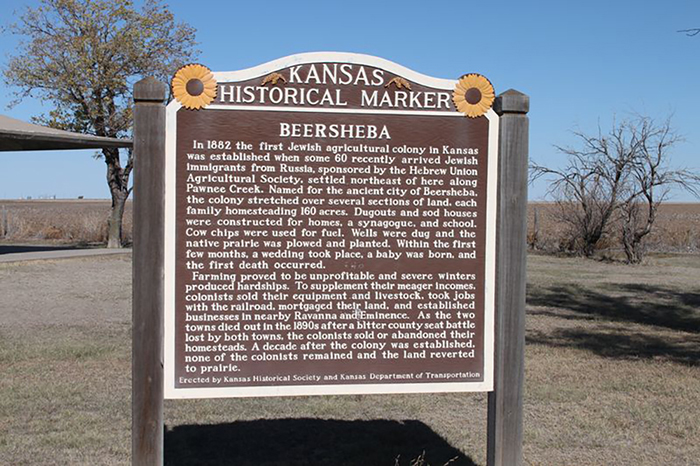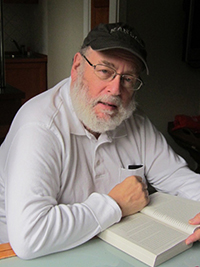Book to place history of Kansas Jews in regional context

LAWRENCE — The history of Midwest Jews is an area ripe for scholarship, and the University of Kansas is well-placed to be a center of such study, according to a researcher who has begun working on a book on the subject.
 David Katzman, professor emeritus of American studies, received a grant from the Overland Park-based Barton P. and Mary D. Cohen Charitable Trust to write and edit a history of the Jews of Kansas. Katzman will give an update on his progress in his keynote speech at the “Jews in the Midwest: c. 1850-1950” symposium Sunday, Nov. 12, at the Oread Hotel. Top Jewish historians from around the country will also participate in the event, which is free and open to the public. Click here for details.
David Katzman, professor emeritus of American studies, received a grant from the Overland Park-based Barton P. and Mary D. Cohen Charitable Trust to write and edit a history of the Jews of Kansas. Katzman will give an update on his progress in his keynote speech at the “Jews in the Midwest: c. 1850-1950” symposium Sunday, Nov. 12, at the Oread Hotel. Top Jewish historians from around the country will also participate in the event, which is free and open to the public. Click here for details.
In addition to the grant money, Katzman said he and his two postdoctoral student researchers benefited from the Cohens’ own decade-long research. The late Barton Cohen was a banker, and Mary Cohen had a career as a teacher and college administrator before turning to philanthropy full-time.
“For dozens of years, Barton and Mary Cohen had done research on Jews in Kansas,” Katzman said. “I don’t think the subject lends itself well to a narrative history, however, so we’ll produce a reference work with individual essays on towns, events and people who will shed light on Jews, on Kansas itself and on Midwest Jewry. We hope to complete the project this spring.”
Katzman said the book and seminar “fit in well with a revival of interest in the history and culture of the Midwest.”
Scholars at Midwestern universities like KU, Katzman said, have renewed interest in the Midwest. Once a major focus of American history and culture, the Midwest — the plains and prairie states — has been neglected among American scholars in the last 75 years.
“With the revival of Midwest history, the time is right to include Jews in all of this,” Katzman said. “We need to study the heartland if we are going to put together the United States of America.”
Katzman said the history of small-town Midwestern Jews has been overlooked until now for a variety of reasons, not least the dearth of records of institutions.
“We have identified 700 to 1,000 small towns where Jews lived, but scholars have missed them,” he said. “The traditional way scholars defined a Jewish community was by the presence of a synagogue, which generated records.”
In the Midwest, on the other hand, 19th-century Jewish immigrants tended to be merchants and to be highly mobile, a condition made possible in part by the growing railroads.
“They were used to living in Europe in towns without synagogues, so they were comfortable in small Midwestern towns,” Katzman said. “Many of them spoke three, four or five languages, so it was easy to pick up English. They came with enormous reserves of human capital. They used family connections to get here. They came as the region was opening up to white settlement, when there was more opportunity. And if a town didn’t work out, they moved on quickly … so the merchants didn’t invest in synagogues. They were quite capable of running their own religious services, so they rented halls for the high holidays, as they did in Lawrence and Topeka, or they held services in their own homes, as in Salina, which could hold 50 to 60 people.”
Abraham Summerfield, for instance, settled in Eudora before moving to Lawrence.
“He was a member of the first Eudora City Council in 1859,” Katzman said. “But in six or seven years, that family left from that small town. There is a lot to learn about why they came and why they left. Eudora was not the county seat. It was not on a navigable river, and the major railroads passed them by. But nearby Lawrence flourished, so most of Eudora’s Jews moved on.”
Summerfield Hall on the KU campus is named after Abraham Summerfield’s grandson, Solon. Marcus Summerfield, Abraham’s son and Solon’s father, was the first Jewish professor at KU.
If there are no synagogue records historians can draw on, Katzman said, the region’s daily and weekly newspapers provide a rich source of material.
“Merchants were major advertisers in the small papers,” he said. “They established boards of trade and chambers of commerce in each community. They were also into banking. Jews, as prominent merchants, were on the boards of directors of banks.”
Similarly, the activities of these prominent merchants were also noted in their local newspapers.
“The social columns of these papers are like a 19th- and early 20th-century Facebook,” Katzman said. “We know who went to Topeka or Kansas City for high holiday services, who closed their store, etc.”
In this way, Katzman said, “we understand how the Midwest shaped their lives and how they shaped the Midwest.”
For instance, Katzman said, those early merchants served as modernizing forces.
“They were always upgrading their stores,” Katzman said. “They installed plate-glass windows to invite people in. They added improved lighting and electricity, elevators and central heating. Telephones came in as part of commerce. The stores themselves stocked the latest fashions. They were also innovators of the automobile, enhancing their own mobility and introducing home delivery.”
One surprising thing Katzman and his researchers uncovered: Despite its status today as a New York City retailing icon, the first Bloomingdale’s store was in Leavenworth.
Beyond simply documenting their existence, the book project aims to place Kansas’ early Jewish residents into a regional context. There will be essays on Jewish literature in Kansas, on the failed utopian agricultural colonies, the projects to disperse Jews away from East Coast slums and to the nation’s interior, and more.
“The question is what did they do? Why is it important? Midwest history tended to be lost in the late 20th century, so this contextualizes history,” Katzman said. “It’s larger than Kansas. The South tended to resist immigration and modernization. Jews in the Midwest found themselves between black and white.”
KU’s relatively fledgling Jewish studies program is not going to challenge, say, University of California-Berkeley, Michigan or Indiana as centers of scholarship on European Jewry, Katzman said. But it could well become a home for the study of Midwestern Jewish communities.
At top: A Kansas Historical Society sign marks the former site of Beersheba, a 19th-century Jewish agricultural colony in Finney County. Photo courtesy of the Kansas Historical Society. At right: David Katzman, KU professor emeritus of American studies.